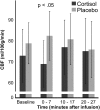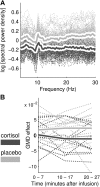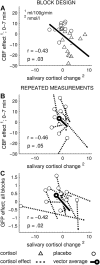Tune it down to live it up? Rapid, nongenomic effects of cortisol on the human brain
- PMID: 22238097
- PMCID: PMC6621076
- DOI: 10.1523/JNEUROSCI.2384-11.2012
Tune it down to live it up? Rapid, nongenomic effects of cortisol on the human brain
Abstract
The stress hormone cortisol acts on the brain, supporting adaptation and time-adjusted coping processes. Whereas previous research has focused on slow emerging, genomic effects of cortisol, we addressed the rapid, nongenomic cortisol effects on in vivo neuronal activity in humans. Three independent placebo-controlled studies in healthy men were conducted. We observed changes in CNS activity within 15 min after intravenous administration of a physiological dose of 4 mg of cortisol (hydrocortisone). Two of the studies demonstrated a rapid bilateral thalamic perfusion decrement using continuous arterial spin labeling. The third study revealed rapid, cortisol-induced changes in global signal strength and map dissimilarity of the electroencephalogram. Our data demonstrate that a physiological concentration of cortisol profoundly affects the functioning and perfusion of the human brain in vivo via a rapid, nongenomic mechanism. The changes in neuronal functioning suggest that cortisol acts on the thalamic relay of background as well as on task-specific sensory information, allowing focus and facilitation of adaptation to challenges.
Figures





Similar articles
-
Brief Report: Low-Dose Hydrocortisone Has Acute Enhancing Effects on Verbal Learning in HIV-Infected Men.J Acquir Immune Defic Syndr. 2017 Jul 1;75(3):e65-e70. doi: 10.1097/QAI.0000000000001303. J Acquir Immune Defic Syndr. 2017. PMID: 28141781 Free PMC article. Clinical Trial.
-
The stress-buffering effect of acute exercise: Evidence for HPA axis negative feedback.Psychoneuroendocrinology. 2015 Jan;51:414-25. doi: 10.1016/j.psyneuen.2014.10.019. Epub 2014 Oct 25. Psychoneuroendocrinology. 2015. PMID: 25462913 Clinical Trial.
-
Neural circuitry of emotion regulation: Effects of appraisal, attention, and cortisol administration.Cogn Affect Behav Neurosci. 2017 Apr;17(2):437-451. doi: 10.3758/s13415-016-0489-1. Cogn Affect Behav Neurosci. 2017. PMID: 28032303 Clinical Trial.
-
The brain and the stress axis: the neural correlates of cortisol regulation in response to stress.Neuroimage. 2009 Sep;47(3):864-71. doi: 10.1016/j.neuroimage.2009.05.074. Epub 2009 Jun 13. Neuroimage. 2009. PMID: 19500680 Review.
-
The cortisol awakening response (CAR): facts and future directions.Int J Psychophysiol. 2009 Apr;72(1):67-73. doi: 10.1016/j.ijpsycho.2008.03.014. Epub 2008 Sep 30. Int J Psychophysiol. 2009. PMID: 18854200 Review.
Cited by
-
Stress and neurodevelopmental processes in the emergence of psychosis.Neuroscience. 2013 Sep 26;249:172-91. doi: 10.1016/j.neuroscience.2012.12.017. Epub 2013 Jan 5. Neuroscience. 2013. PMID: 23298853 Free PMC article. Review.
-
Rapid Action of Retinoic Acid on the Hypothalamic Pituitary Adrenal Axis.Front Mol Neurosci. 2019 Oct 30;12:259. doi: 10.3389/fnmol.2019.00259. eCollection 2019. Front Mol Neurosci. 2019. PMID: 31736706 Free PMC article.
-
Developmental mechanisms in the prodrome to psychosis.Dev Psychopathol. 2013 Nov;25(4 Pt 2):1585-600. doi: 10.1017/S0954579413000783. Dev Psychopathol. 2013. PMID: 24342857 Free PMC article. Review.
-
Learning and memory under stress: implications for the classroom.NPJ Sci Learn. 2016 Jun 29;1:16011. doi: 10.1038/npjscilearn.2016.11. eCollection 2016. NPJ Sci Learn. 2016. PMID: 30792896 Free PMC article. Review.
-
Intranasal insulin increases regional cerebral blood flow in the insular cortex in men independently of cortisol manipulation.Hum Brain Mapp. 2014 May;35(5):1944-56. doi: 10.1002/hbm.22304. Epub 2013 Aug 1. Hum Brain Mapp. 2014. PMID: 23907764 Free PMC article. Clinical Trial.
References
-
- Alsop DC, Detre JA. Reduced transit-time sensitivity in noninvasive magnetic resonance imaging of human cerebral blood flow. J Cereb Blood Flow Metab. 1996;16:1236–1249. - PubMed
-
- Bell AJ, Sejnowski TJ. An information-maximization approach to blind separation and blind deconvolution. Neural Comput. 1995;7:1129–1159. - PubMed
-
- Bloomfield P. Fourier analysis of time series: an introduction. New York: Wiley; 1976.
-
- Brunia CH. Neural aspects of anticipatory behavior. Acta Psychol (Amst) 1999;101:213–242. - PubMed
-
- Chatrian GE, Lettich E, Nelson PL. Modified nomenclature for the “10%” electrode system. J Clin Neurophysiol. 1988;5:183–186. - PubMed
Publication types
MeSH terms
Substances
LinkOut - more resources
Full Text Sources
